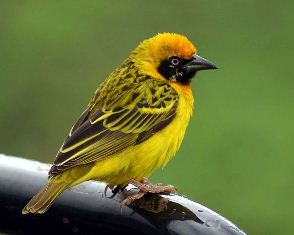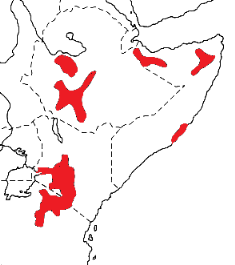Weaver Wednesday [44]: Speke's Weaver 2013-04-17 (354)
 Weaver Wednesday
Weaver Wednesday


The Speke's Weaver Ploceus spekei is a large weaver with a long, heavy bill and pale eye in both sexes. The breeding male (see above) has the black mask extending to the upper breast where it is fringed with chestnut. The similar male Village Weaver P. cucullatus has a red eye. The similar male Heuglin's Weaver P. heuglini is smaller and does not overlap in range. The female Speke's Weaver is dull coloured and lacks the prominent yellow supercilium and bright yellow breast of the female Village Weaver.

No subspecies of the Speke's Weaver are recognised (see map right, based on Birds of Africa). Speke's Weaver is common in East Africa, occurring in western Ethiopia, north and east Somalia, south-west and central Kenya to north central Tanzania.
Speke's Weaver inhabits bushed country and woodland with available water - nesting colonies may be abandoned if local water supplies run out. It is common in urban and suburban areas in Kenya. It feeds on seeds including those of crops such as maize, and is regarded as a crop pest in some areas. It also feeds on insects, including alate termites, especially when feeding its young. It is generally found in small flocks.

The Speke's Weaver is polygynous and colonial, but sometimes nests singly. It may breed in large mixed colonies with Lesser Masked Weavers P. intermedius or Chestnut Weavers P. rubiginosus. Of 40 colonies in Nairobi, 60% were near a busy road or occupied building, and 65% were sited in acacia trees (40% were in fever trees Acacia xanthophloea). Some nests have been built in Eucalyptus trees. Usually the entire colony is in a single tree, with 22-205 nests. More than half of the permanent colonies are active twice a year (breeding periods (Mar-May and Oct-Dec). Males arrive at the colony first to start nest construction.

The nest is a bulky, oval structure, with the entire upper surface attached to the underside of a twig. The entrance is narrow, with a
short spout. The nest is roughly woven of grasses, including grass stems, stems with leaves and grass heads attached. There is an interior ceiling of grass heads and some acacia leaves. The chamber floor is lined with different grass heads. Unused or incomplete nests are torn down, to litter the ground below the nesting tree. The male builds a nest in 8-10 days, and a female adds lining once she has accepted a nest and male. One male may have 4-14 nests within a colony.
Breeding success is reduced in nests with fly larvae Passeromyia heterochaeta, and some nests suffer from mites and fleas. Some colonies experience mass desertion, as shown by many dead chicks in colonies. Predators include Augur Buzzard Buteo augur, Yellow-billed Kite Milvus migrans and Gabar Goshawk Melierax gabar.

The Speke's Weaver has 5 PHOWN records from 3 countries and many more PHOWN records are needed for this species (see PHOWN summary). Newly-built nests, active or old nests may be used for breeding or roosting by a variety of species including Red-cheeked Cordon-bleau Uraeginthus bengalus, Northern Grey-headed Sparrows Passer diffusus, Cut-throat Finches Amadina fasciala, or Superb Starlings Spreo superbus, so keep a look out for such ecological records. Submit any weaver nest records to PHOWN (PHOtos of Weaver Nests) via the Virtual Museum upload site.
PHOWN summary
Previous Wedn: Speckle-fronted Weaver
Full weaver species list
| 

 Weaver Watch
Weaver Watch


